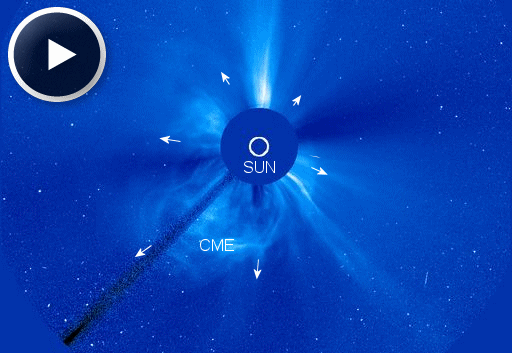COLDEST SPOT IN THE KNOWN UNIVERSE: NASA engineers are building a refrigerator for the International Space Station that can make atoms colder than anything else in the known universe. Inside this "Cold Atom Lab," researchers hope to discover new forms of matter and novel quantum phenomena. Get the full story from Science@NASA.
INCOMING CME, CHANCE OF STORMS: Big sunspot AR1967 is crackling with solar flares and hurling CMEs into space. The biggest CME so far was propelled away from the sun on Jan. 30th by an M6-class explosion in the sunspot's magnetic canopy. It is expected to reach Earth on Feb. 2nd:
The blast was not squarely Earth-directed. Instead, it will deliver a glancing blow to our planet's magnetic field. NOAA forecasters estimate a 45% chance of polar geomagnetic storms when the cloud arrives on Sunday. High-latitude sky watchers should be alert for auroras. Aurora alerts: text, voice

Solar wind
speed: 340.6 km/sec
density: 2.2 protons/cm3
explanation | more data
Updated: Today at 2007 UT
X-ray Solar Flares
6-hr max: C3 1401 UT Feb01
24-hr: M3 0723 UT Feb01
explanation | more data
Updated: Today at: 2000 UT
![]()
Daily Sun: 01 Feb 14
Sunspot AR1967 has a 'beta-gamma-delta' magnetic field that harbors energy for X-class solar flares. Credit: SDO/HMI
![]()
Sunspot number: 87
What is the sunspot number?
Updated 31 Jan 2014
Spotless Days
Current Stretch: 0 days
2014 total: 0 days (0%)
2013 total: 0 days (0%)
2012 total: 0 days (0%)
2011 total: 2 days (<1%)
2010 total: 51 days (14%)
2009 total: 260 days (71%)
Update 01 Feb 2014
The Radio Sun
10.7 cm flux: 166 sfu
explanation | more data
Updated 01 Feb 2014
![]()
Current Auroral Oval:
Switch to: Europe, USA, New Zealand, Antarctica
Credit: NOAA/POES
![]()
Planetary K-index
Now: Kp= 1 quiet
24-hr max: Kp= 1 quiet
explanation | more data
Interplanetary Mag. Field
Btotal: 5.0 nT
Bz: 3.7 nT south
explanation | more data
Updated: Today at 2007 UT
![]()
Coronal Holes: 01 Feb 14
There are no large coronal holes on the Earthside of the sun. Credit: SDO/AIA.





